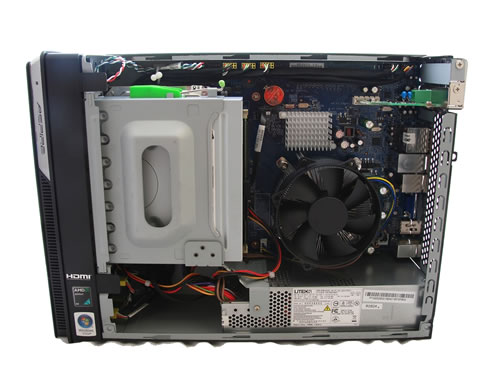Hardware and Initial Setup Impressions
The right side panel of the X1200 has two perforated areas that allow cool air to be drawn inside. The larger one is directly over the CPU heatsink while the second is positioned over the PCI Express expansion slots. There are two PCIe slots in this system (x1 and x16), with the x1 being occupied by a V.92 modem by default.

Because the x16 slot is low-profile you are limited on the type of add-in card you can use in it. Most video cards that will fit here won't offer much of a performance gain over the on-board GeForce 8200 graphics, but other hardware like a TV tuner could become a viable option.
Acer has certainly done a nice job of packing everything into this tiny space. All cables are out of the way and do not impede airflow or otherwise hamper cooling.

Around the back we find the modem occupying the x1 add-in card slot. Below the modem are five audio jacks, a Gigabit Ethernet port, four USB ports, an eSATA port, VGA connector, HDMI port and two PS/2 ports for the keyboard and mouse. At the bottom of the chassis is the power supply, sporting a tiny exhaust fan.
For a PC of this size and price point, I was pleasantly surprised that Acer included an eSATA port, HDMI port and the full 5.1-channel audio jacks. The eSATA port will work great with an external hard drive, while the HDMI port and audio support will certainly help integrating this system into your home theater. That is, if the X2 4850e has enough horsepower under the hood to handle the job.
Initial Setup impressions
Setting up the X1200 was no different from most other computers, although I did run into a slight issue since there is no DVI-out connection and a VGA-to-DVI adapter is not part of the bundle. The way I went was using the HDMI connection in conjunction with an HDMI-to-DVI cable I was using for my television.
The Phoenix Award BIOS offers a familiar layout but just as any other manufactured system, options are extremely limited - which is probably a good thing. About the only thing of interest or concern I found in the BIOS was a relatively low +12v line reading of 11.70V.
Booting up for the first time, I was prompted to go through the usual Windows setup processes (naming your PC, etc.). I was also presented the option to install some of the 60-day trial software bundled with the system, such as McAfee Security Center. After these formalities, I then had to download and install 22 Windows updates. A quick reboot was in order before I was free and clear.
The operating system in general was not overly loaded down with useless program installations as is the case with many manufactured systems. There were, however, some items that I could do without (a few random children games, for example), but those were easily uninstallable via Add/Remove programs.



